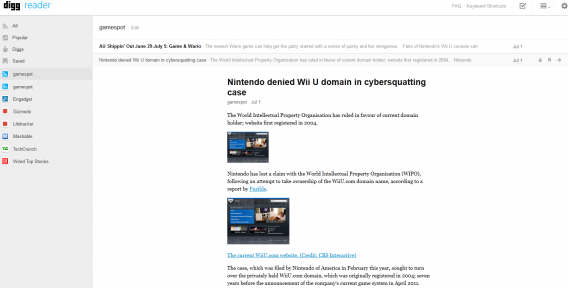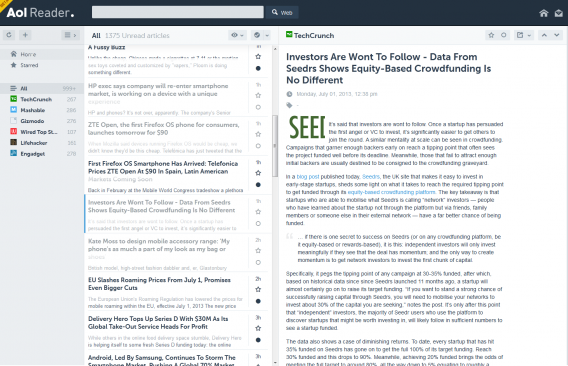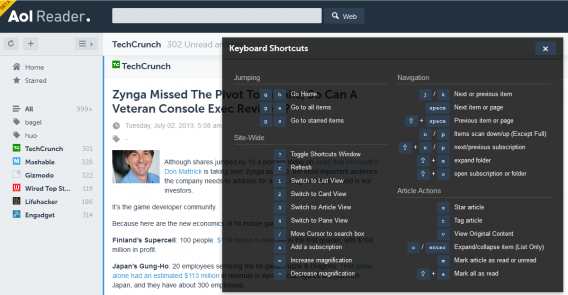Google Reader is officially dead, but three powerful web-based RSS readers are vying for control of the news space. Digg Reader, Feedly, and AOL Reader all have their merits and we’ve tested them out to see what each excels at. While all of these readers are in beta, they function similarly to Google Reader and can be adapted as your new primary RSS reader.
Views and customization


These Google Reader replacements have functionality and appearance similar to the former. Some of them are also expanding their customization to offer more than Google Reader ever provided. Digg Reader is the most basic of the three, featuring only two viewing options: List, which displays simple headlines, and Expanded which adds in the story’s first paragraph and art.

Both Feedly and AOL Reader have four total views. Besides List, both have Full which show the entire article unlike Digg’s shorter Expanded view. Feedly and AOL Reader also have Card views, which display story cards similarly to Pinterest; Feedly keeps all cards the same size regardless of content, while AOL Reader will stretch and squeeze cards depending on the story’s art. Feedly also has a Magazine view that is basically List view with a small picture and intro paragraph for each article, while AOL reader has a Pane view that turns that separates the list and article into panes similar to email.

Feedly edges out the view options simply because each can be toggled immediately from buttons at the top of the interface; both Digg Reader and AOL Reader require a dropdown menu, which AOL even hides when on the home screen. AOL Reader does have a lot of customization in other places, such as font sizes, visual themes, and organization of unread stories.
The lack of viewing options might seem to hurt Digg Reader, they gain points from the fact that you can rearrange feeds on the left module via drag-and-drop. Neither Feedly nor AOL Reader have this cool and convenient feature.
Finding and organizing stories

Being connected to the larger Digg network, Digg Reader features a Popular tab that displays the hottest and most viewed stories on the internet. Although Digg’s popularity waned in 2010 to competitors such as Reddit, Digg was among the first and most used social news sites. With Digg Reader you can also directly Digg any story quickly and view all of your own Diggs at once. It’s a nice means of integrating social aspects and knowing what exactly people are interested in.

AOL and Feedly instead allow you to insert tags for any story, which will then display on the left-hand module. AOL Reader makes tags slightly more predominant and faster to add, but they function similarly in both readers. Unless you’re a power user that will be searching through old stories often, tags are more a novelty.

All three readers have keyboard shortcuts, though Feedly’s list is more hidden and and doesn’t show all of the shortcuts. For instance GH to go to the All section isn’t listed (though, the alternate GA also works). Both Digg Reader and AOL Reader have a large array of shortcuts allowing you to easily change views, tag, share, and find new stories. AOL Reader even has shortcuts to switch through folder and subscriptions, or expand lists. These shortcuts make it very quick to navigate without constantly clicking everywhere.
Clutter and downfalls

Each reader has minor flaws that can start to be rather annoying after time. Both Digg Reader and Feedly tend to be laggy. In Feedly this likely comes from the amount of smooth animations everywhere, which while aesthetically pleasing aren’t necessary for an RSS reader. Digg Reader’s slowness comes when loading older stories that might be several days old, which is unlikely to occur unless you’ve missed reading your feed for a long amount of time.

Feedly allows the quickest unsubscribing from unwanted feeds, while Digg Reader adds in an extra step of having to enter a sub menu on each feed individually to edit and remove feeds. AOL Reader goes even a step further by requiring you to enter a separate settings menu to delete and even rearrange your feeds. While the intention is likely to avoid accidentally deleting feeds, both Digg Reader and AOL Reader go a little overboard with the extra amount of clicks and menus.
The right reader
None of these RSS readers are perfect, nor are they an identical replacement for Google Reader. Each has appealing aspects that will feed the needs of different users depending on frequency of use and amount of control. Here’s a summary of which reader fits whom:
- Digg Reader is the most like Google Reader, very basic without many extra features. Its connection with Digg does mean that it has a slight social aspect, but only if you use that service. Overall it should be your pick if you want a basic, no thrills RSS feed.
- AOL Reader has a lot of customization. If you need control of how your feed looks, feels, and don’t mind juggling through menus than this is an excellent choice.
- Feedly looks and feels different to Google Reader, making it a much fresher experience. It has more options than Digg Reader, but lacks both customization and fluff from AOL Reader. This should be your choice if you want balance and were tired of the old Google functionality.
This is how these RSS readers handle at the moment, but things are certainly bound to change. With the market filled with three big choices (along with other smaller ones), each company will be motivated to add in new features and make tweaks. These are only betas, so your own choice might quickly change in the future.
For now, which reader are you using?

